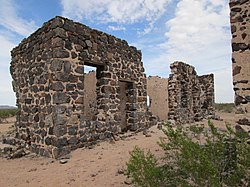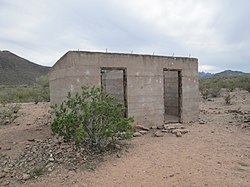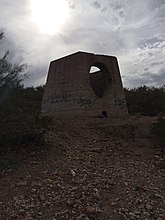Sasco, Arizona
Sasco, Arizona | |
|---|---|
MST (no DST )) | |
| Post Office opened | July 10, 1907 |
| Post Office closed | September 15, 1919 |
Sasco is a
History
Sasco owes its existence to the Development Company of America (DCA), which was headed by
In 1903, Murphy and his chief engineer, William Field Staunton, purchased the Union Mine and the Mammoth Mine in the Silver Bell Mountains and combined them to form the Imperial Copper Company and the Silver Bell Mine. One year later, DCA built the Arizona Southern Railroad to connect the Silver Bell Mine with the
When the smelter was finished, work on the town and efforts to attract settlers were undertaken. Soon the town of Sasco was home to a residential neighborhood of 600 people, as well as a few stores and
Although Sasco was set to become "one of the premier smelting towns in the
Asarco closed the Silver Bell Mine in 1921 to focus on operations elsewhere, and in late 1933 most of the buildings in Sasco were demolished, along with the railroad that served the town. The remains of several structures can still be visited today, including the Hotel Rockland, the Sasco Jail, and the smelter complex. According to James E. Sherman, in his book Ghost Towns of Arizona, old broken glass and rusty cans can be found all over the area. The Sasco Cemetery is located northeast of the town site, next to the La Osa Ranch house.[3][4]
Gallery
-
The smelter complex at Sasco in 1910.
-
The Hotel Rockland sometime before 1921.
-
The Hotel Rockland in 2014.
-
The Sasco Jail was built of concrete to stop prisoners from escaping.
-
The ruins of the smelter at Sasco.
See also
References
- ^ U.S. Geological Survey Geographic Names Information System: Sasco
- ISBN 978-0914846109.
- ^ a b c d e f "Experience Arizona: Sasco". Retrieved March 3, 2014.
- ^ ISBN 0806108436.
- ^ "Sasco to Silverbell". HikeArizona.com. Retrieved March 3, 2014.
- ^ a b "Silver Bell Complex, Vignettes in Time Exhibit, BLM". Retrieved March 3, 2014.
External links
 Media related to Sasco, Arizona at Wikimedia Commons
Media related to Sasco, Arizona at Wikimedia Commons Ghost towns travel guide from Wikivoyage
Ghost towns travel guide from Wikivoyage- Sasco description and photos
- Sasco – Ghost Town of the Month at azghosttowns.com






